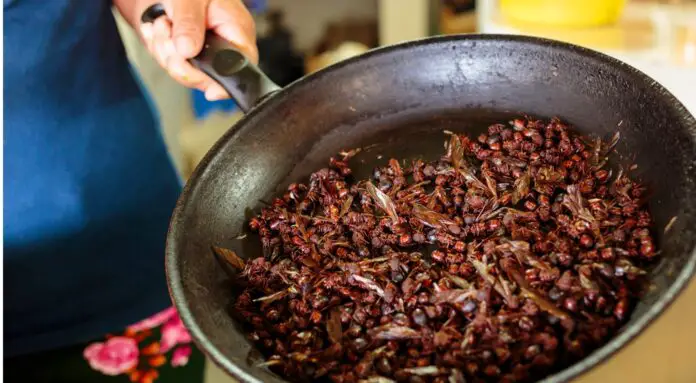
In early June, before the start of the wet season, Oaxaca is abuzz with anticipation. The first rains are expected to wash away the fine dust that has accumulated during three months of drought and heat, and the aquifers will refill. Within days, the rolling hills of the Central Valley will turn from straw-colored to green, and the prickly pears will be covered in flowers, turning the slopes pink. For many Oaxacans, the first rains also mean the start of the fleeting chicatana season.
In Oaxaca, chicatanas (flying leaf-cutting ants) arrive just a day or two after the first torrential downpour of the season, in early to mid-June. Consumed since pre-Hispanic times in several states of Mexico, but especially in Oaxaca, chicatanas are highly prized for their fatty, salty aftertaste, their umami and the crunchiness they add to sauces and moles. When their nests are flooded, these plump, winged insects emerge to the surface in search of a new refuge: this is the moment that many Oaxacans take advantage of to rush out and collect them. Some “hunters” use plastic bags to catch them in the air, while others collect the chicatanas by hand, placing their bodies one by one in containers, taking care to avoid their painful sting. They are then roasted on the comal (the typical clay griddle of Oaxaca) to scorch the wings and prepare the ants for packaging and sale or to enjoy their flavor immediately.
In Oaxaca, it is not unusual to eat insects. The chapulines (grasshoppers) and maguey worms found in markets throughout the city are used to season guacamole at an informal food place, or to complete the tasting menu at one of the city’s culinary institutions. Chicatanas, on the other hand, are a delicacy that is more sought after than other insects, both because of the ephemeral nature of their season and the complexity of their flavour.
Entomophagy (i.e. the practice of eating insects) has been a common custom throughout the world for centuries. In the case of Mexico, its practice predates the arrival of the Spanish. Chicatanas have always been an important part of the diet in Mesoamerica, since their consumption provides vitamins, minerals, essential fatty acids and proteins.
Today, chicatanas have ceased to be an essential source of nutrients and have become more of a cultural curiosity and a seasonal treat. The fleeting nature of their appearance makes the collection, cooking and enjoyment of chicatanas a ritual that communities eagerly await year after year. In recent years, however, chicatanas have stopped being enjoyed in the same quantities as in the past. Climate change, fertilizers, physical interventions that destroy the anthill, and commercialization that has driven up their price mean that some Oaxacan communities are losing the ritual of eating chicatanas. As a consumer, there are some responsible ways to enjoy these fatty, crunchy, umami-packed morsels.
For those lucky enough to visit Oaxaca during the months of June, July, and August, you can ask for chicatanas mole at restaurants like Teocintle-Tika’aya (with One MICHELIN Star), Levadura de Olla Restaurante, or Bib Gourmand Tierra del Sol. If you live in the United States, you can order a can from Masienda, a Mexican sustainable sourcing company that is very serious about the traceability of all its products and that puts small quantities of chicatanas on the market every year.
In Mexico City, two-MICHELIN-starred Quintonil features them on the menu, and if you’re in the U.S., consider ordering a can from Masienda, a Mexican sustainable food company that offers small batches of chicatanas each year and publishes sourcing reports for all of its products.
Source: guide.michelin






